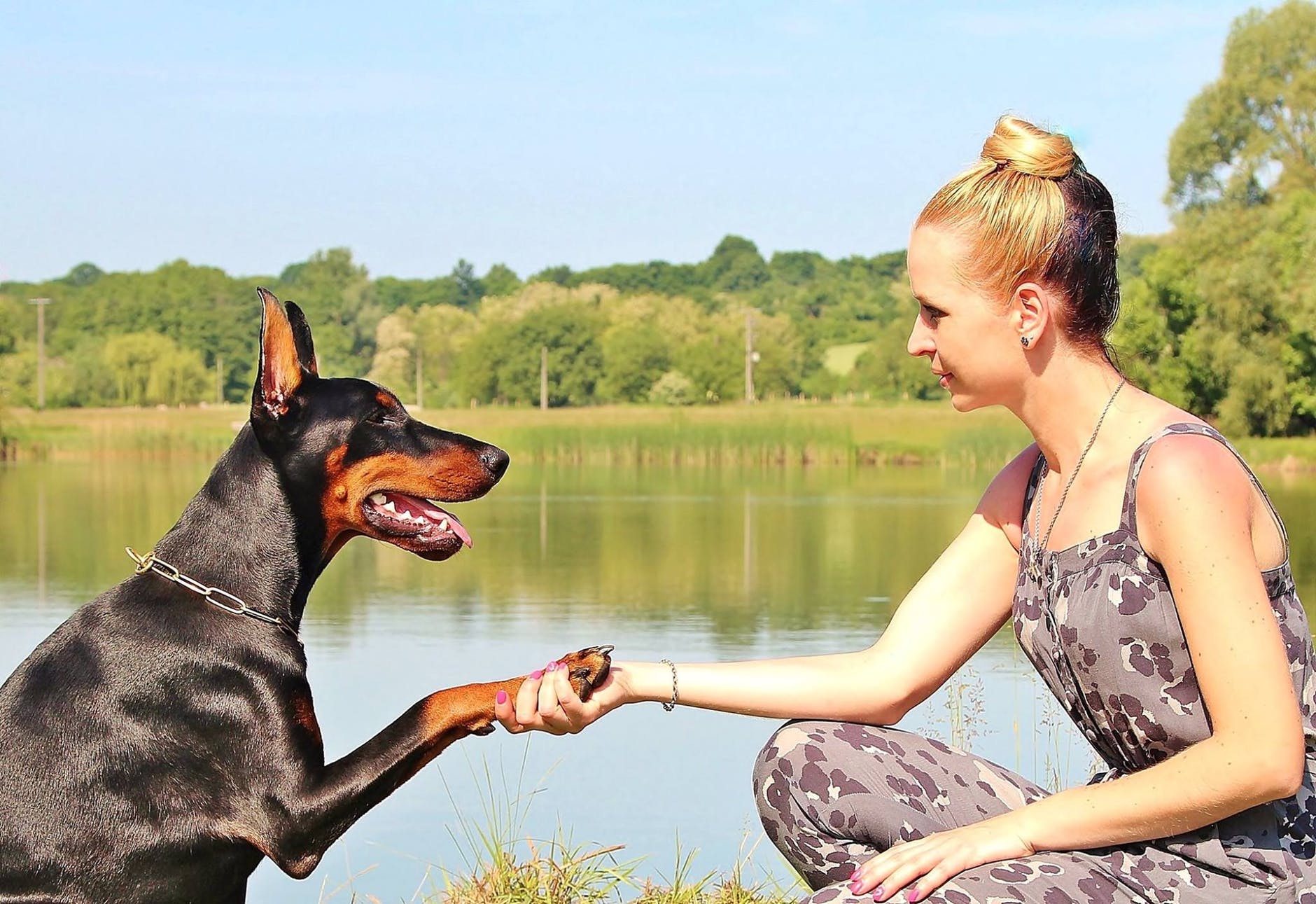You’d think that swimming would come naturally to almost all dogs—some dogs do take to swimming naturally; however, others need lessons and encouragement to learn to swim. If you find yourself needing to teach your dog to swim, then you’ve come to the right place.
Connect with a verified veterinarian in minutes. Licensed vets are available 24/7 to answer your questions. No need to worry about your furry family member.
Dogs & Drowning
Not all dogs naturally know how to swim or even like to be in the water. Many people, including pet parents, have the mistaken belief that all dogs take to water with no problems. That’s simply not the case. Dogs can drown very easily. Some instances of dogs drowning are simply due to the fact they aren’t able to get out—for example, if your pup falls into your backyard pool and can’t find a way to get out. He could swim until exhausted and tired, and then drown.
Pets can also drown if they suffer from certain medical conditions such as dementia, arthritis, heart problems, and blindness. In these cases, dogs with such conditions should never be left near water (bathtub, pool, lake, etc.) unattended. It’s just not safe.
Now, let’s take this to a more positive level and learn about the benefits of dogs learning to swim!
Benefits of Teaching Your Dog to Swim
Swimming offers many health benefits for us and our fur babies! Swimming is an excellent exercise that doesn’t tax your pup’s joints. It can help with behavioral problems such as too much energy, destructive behaviors or even boredom. Exercise can help relieve your dog of these issues by tiring him out physically as he has a good time swimming.
Being in the water is also an excellent way for your dog to stay cooler on hot days. Even a kiddie pool can help!
Teaching your dog to swim may be more than just a safety necessity—it may be a skill he needs if he helps you with hunting, fishing and more.
Swimming can also help keep your dog’s weight down by using up extra calories. He’ll stay fit and trim, while having fun and keeping obesity at bay

Review symptoms, medications & behavior to keep your pets healthy with a Vet Online in just minutes.
Ask a Vet Live NowFirst Things First: Safety & a Doggie Lifejacket
You’ll want to make sure your dog stays safe in the water as he learns to swim. Just like people sometimes need some form of floating device to learn to swim, dogs can also benefit from such a device. In fact, the best piece of equipment is a lifejacket made especially for dogs. The lifejacket will keep your dog afloat and safe from drowning. Drowning accidents, even with pets, can happen all too quickly. So be sure to keep your fur baby safe with a lifejacket.
Make sure the lifejacket is the right size for your pup and make certain it has a handle on back that allows you to easily grab hold your pet in the water. Also look for a D-ring on the lifejacket where you can attach a leash, if necessary.
You’ll need to get your dog familiar with wearing the lifejacket before you put him in the water. You can do this easily at home where he’s comfortable and relaxed. You could try to put the lifejacket on him before he eats or any time during the day. It’s best to start off with short periods in the beginning, gradually lengthening the amount of time he wears the lifejacket. And don’t forget to reward your canine companion with treats, praise and attention when he wears it. But only reward him if he’s not trying to chew or rub it off! Once he’s comfortable in the lifejacket, then you’ll be able to start slowly introducing your dog to water and swimming.
Doggie CPR & First Aid
Don’t forget to learn pet CPR and other emergency care procedures for your canine companion. You may find doggie first aid classes at your local Red Cross, your vet, etc. You’ll want to do know how to care for your pet in case of an emergency—preparedness can mean the difference between life or losing your pet.
Start Off in Shallow Water
It’s best to start your dog off in shallow water, where he can comfortably place his feet on solid ground. You might even put him on the leash and then slowly walk him into the water, coaxing him gently and praising him as he walks further with you. You can also offer treats to encourage him to go into the water with you.
As you slowly coax your dog into the water, be sure to stop if he becomes frightened or nervous. Give him a few minutes to get used to the feel of wearing the lifejacket in the water. The buoyancy of the water may be a little surprising, until he gets used to it. Just go at your dog’s rate—don’t force him into deeper water if he’s not ready.
When your dog’s comfort increases with the increasing water depth, keep coaxing him to you. Walk a little farther out, until eventually your dog needs to start swimming to you. But remember to stop if he becomes too nervous or scared. It may take a few trials to get him used to being in the water. Forcing him will only increase his fear—you want to avoid this at all costs.
What About Teaching My Dog to Swim in a Bathtub?
Another option is to teach dog to swim in bathtub. You both might feel more comfortable with doggie swimming lessons in the bathtub. This works best for small and medium sized dog breeds. Larger breeds will need to learn in a swimming pool, due to their size!
Again, you might want to consider using a doggie lifejacket even in the bathtub. This way you’ll have a quick and easy way to get a hold of your dog if he starts to flounder. Not only that, but if you’ll be canoeing, or boating (all kinds of boats), then you’ll need to make sure your fur baby stays safe in the water by wearing a doggie lifejacket. As we mentioned earlier, be sure he’s used to the lifejacket before putting him in the bathtub with the jacket on.
It’s also helpful to keep some treats on hand as rewards for your pup’s good behavior during his swimming lessons. Not only that, the treats are a great motivator to get him to swim! Toys are also a great incentive!
Use the same method we used in the previous section to get your pup used to the water and helping him learn to swim.
Teach Dog to Swim Underwater
Is it safe for dogs to swim underwater? Do dogs hold their breath underwater? The short answer to these questions is yes! Dogs can safely learn to swim underwater and hold their breath while doing so, but you’ll want to make sure your fur baby can safely swim, first. He’ll need to be comfortable in the water and know how to swim—you can help him by using the methods we discussed earlier. Once he’s used to the water and enjoys it, then you can begin to teach him to swim underwater. One more note, you’ll need to remove your dog’s lifejacket if he’s going to learn to swim underwater. Don’t do this until your fur baby is completely comfortable in the water and you’ll nearby in case of an emergency.
You’ll need to start him off in water that’s deep enough; a pool, lake or the ocean are great places to practice. His favorite water-safe toys can also be helpful in teaching him to dive underwater. In addition, you may want to have these training sessions about 3 times a week, for about 20 minutes at a time.
While you’re in the water, hold a toy in your hand under the water to entice your fur baby to go after it. When he’s close to getting the toy, move it slowly out of his reach. Then allow him to have the toy—and don’t forget to praise him and give him a treat for trying to grab the treat underwater.
With each underwater swimming session, hold the toy deeper and deeper so your dog has to swim under the water to reach it. Keep him from becoming nervous by staying right with him and offer encouragement and praise as he improves. A few treats will also keep motivate him in the right direction!
You can use this method with all types of toys from frisbees to heavier dog toys—any toy your dog loves and prefers will work. Just repeat these steps and soon your dog will be swimming like a fish underwater!
Dog Swimming Lessons Near Me
If you’re not comfortable teaching your dog to swim, you might consider doggie swimming lessons. You can find swimming classes for dogs by doing a fast and easy Google search. Just use the term “dog swimming classes near me” and hit “Search.” Google, or the search engine you choose, will bring up results of pet swimming classes near your location.
Look for facilities that offer classes for your dog’s age. The lessons can be given in indoor or outdoor properly heated pools. Some classes include you and your fur baby together, or you can look for classes that are included as part of a doggie day care. Some facilities even offer one-on-one classes with your pup, rather than a swimming class with other dogs. This might be best for dogs who don’t socialize well with other dogs.
As with other facilities, you’ll want to make sure the teachers are certified to work with dogs, that they have experience with many different breeds, and that they are knowledgeable about dog emergency first aid, including doggie CPR.
We hope our doggie swimming guide will help you learn how to teach your fur baby how to swim. If you’re not comfortable teaching your dog to swim, there’s also the option of taking him to doggie swimming lessons! Just be sure to keep your pup safe near and in the water and help him learn to have fun and get a great workout at the same time!
Related Sources: BBC USA Today MSU.Edu
Connect with a verified veterinarian in minutes. Licensed vets are available 24/7 to answer your questions. No need to worry about your furry family member.

Tom
Tom has always loved to write since he was little - he wanted to be either a writer or a veterinary doctor, but he ended up being a professional writer while most of his works are based on animals. He was born in San Francisco but later moved to Texas to continue his job as a writer. He graduated from the University of San Francisco where he studied biotechnology. He is happily married and a soon to be father!
Review symptoms, medications & behavior to keep your pets healthy with a Vet Online in just minutes.
Ask a Vet Live Now



